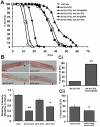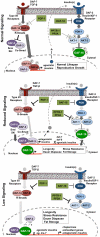PDP-1 links the TGF-β and IIS pathways to regulate longevity, development, and metabolism
- PMID: 21533078
- PMCID: PMC3080858
- DOI: 10.1371/journal.pgen.1001377
PDP-1 links the TGF-β and IIS pathways to regulate longevity, development, and metabolism
Abstract
The insulin/IGF-1 signaling (IIS) pathway is a conserved regulator of longevity, development, and metabolism. In Caenorhabditis elegans IIS involves activation of DAF-2 (insulin/IGF-1 receptor tyrosine kinase), AGE-1 (PI 3-kinase), and additional downstream serine/threonine kinases that ultimately phosphorylate and negatively regulate the single FOXO transcription factor homolog DAF-16. Phosphatases help to maintain cellular signaling homeostasis by counterbalancing kinase activity. However, few phosphatases have been identified that negatively regulate the IIS pathway. Here we identify and characterize pdp-1 as a novel negative modulator of the IIS pathway. We show that PDP-1 regulates multiple outputs of IIS such as longevity, fat storage, and dauer diapause. In addition, PDP-1 promotes DAF-16 nuclear localization and transcriptional activity. Interestingly, genetic epistasis analyses place PDP-1 in the DAF-7/TGF-β signaling pathway, at the level of the R-SMAD proteins DAF-14 and DAF-8. Further investigation into how a component of TGF-β signaling affects multiple outputs of IIS/DAF-16, revealed extensive crosstalk between these two well-conserved signaling pathways. We find that PDP-1 modulates the expression of several insulin genes that are likely to feed into the IIS pathway to regulate DAF-16 activity. Importantly, dysregulation of IIS and TGF-β signaling has been implicated in diseases such as Type 2 Diabetes, obesity, and cancer. Our results may provide a new perspective in understanding of the regulation of these pathways under normal conditions and in the context of disease.
Conflict of interest statement
The authors have declared that no competing interests exist.
Figures






Similar articles
-
End-of-life targeted degradation of DAF-2 insulin/IGF-1 receptor promotes longevity free from growth-related pathologies.Elife. 2021 Sep 10;10:e71335. doi: 10.7554/eLife.71335. Elife. 2021. PMID: 34505574 Free PMC article.
-
DAF-16: FOXO in the Context of C. elegans.Curr Top Dev Biol. 2018;127:1-21. doi: 10.1016/bs.ctdb.2017.11.007. Epub 2018 Feb 2. Curr Top Dev Biol. 2018. PMID: 29433733 Review.
-
Activated AKT/PKB signaling in C. elegans uncouples temporally distinct outputs of DAF-2/insulin-like signaling.BMC Dev Biol. 2006 Oct 4;6:45. doi: 10.1186/1471-213X-6-45. BMC Dev Biol. 2006. PMID: 17020605 Free PMC article.
-
RNA helicase HEL-1 promotes longevity by specifically activating DAF-16/FOXO transcription factor signaling in Caenorhabditis elegans.Proc Natl Acad Sci U S A. 2015 Aug 4;112(31):E4246-55. doi: 10.1073/pnas.1505451112. Epub 2015 Jul 20. Proc Natl Acad Sci U S A. 2015. PMID: 26195740 Free PMC article.
-
Worming pathways to and from DAF-16/FOXO.Exp Gerontol. 2006 Oct;41(10):928-34. doi: 10.1016/j.exger.2006.05.020. Epub 2006 Jul 12. Exp Gerontol. 2006. PMID: 16839734 Review.
Cited by
-
Natural genetic variation drives microbiome selection in the Caenorhabditis elegans gut.Curr Biol. 2021 Jun 21;31(12):2603-2618.e9. doi: 10.1016/j.cub.2021.04.046. Epub 2021 May 27. Curr Biol. 2021. PMID: 34048707 Free PMC article.
-
A functional variant of NEDD4L is associated with obesity and related phenotypes in a Han population of Southern China.Int J Mol Sci. 2013 Apr 2;14(4):7433-44. doi: 10.3390/ijms14047433. Int J Mol Sci. 2013. PMID: 23549273 Free PMC article. Clinical Trial.
-
RNAseq analysis of the parasitic nematode Strongyloides stercoralis reveals divergent regulation of canonical dauer pathways.PLoS Negl Trop Dis. 2012;6(10):e1854. doi: 10.1371/journal.pntd.0001854. Epub 2012 Oct 25. PLoS Negl Trop Dis. 2012. PMID: 23145190 Free PMC article.
-
Automated recognition and analysis of head thrashes behavior in C. elegans.BMC Bioinformatics. 2022 Mar 7;23(1):87. doi: 10.1186/s12859-022-04622-0. BMC Bioinformatics. 2022. PMID: 35255825 Free PMC article.
-
Sex-specific aging in animals: Perspective and future directions.Aging Cell. 2022 Feb;21(2):e13542. doi: 10.1111/acel.13542. Epub 2022 Jan 23. Aging Cell. 2022. PMID: 35072344 Free PMC article. Review.
References
-
- Barbieri M, Bonafe M, Franceschi C, Paolisso G. Insulin/IGF-I-signaling pathway: an evolutionarily conserved mechanism of longevity from yeast to humans. Am J Physiol Endocrinol Metab. 2003;285:E1064–1071. - PubMed
-
- Wolkow CA, Munoz MJ, Riddle DL, Ruvkun G. Insulin receptor substrate and p55 orthologous adaptor proteins function in the Caenorhabditis elegans daf-2/insulin-like signaling pathway. J Biol Chem. 2002;277:49591–49597. - PubMed
Publication types
MeSH terms
Substances
Grants and funding
LinkOut - more resources
Full Text Sources
Research Materials
Miscellaneous

